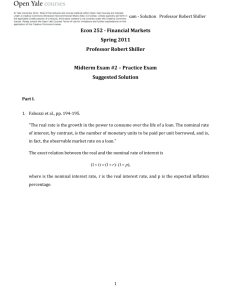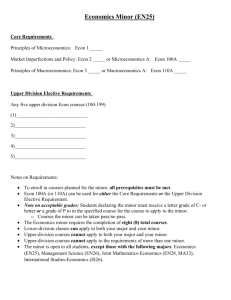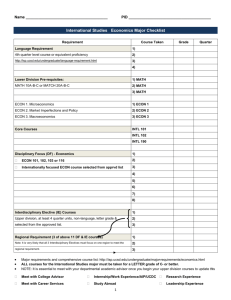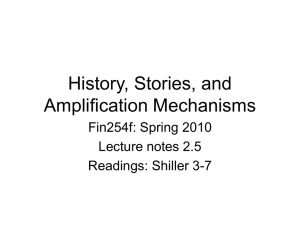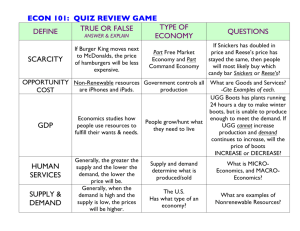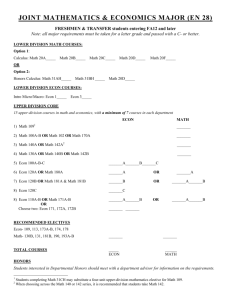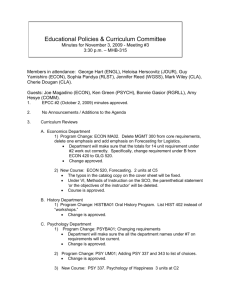Exam Solutions - Open Yale Courses
advertisement
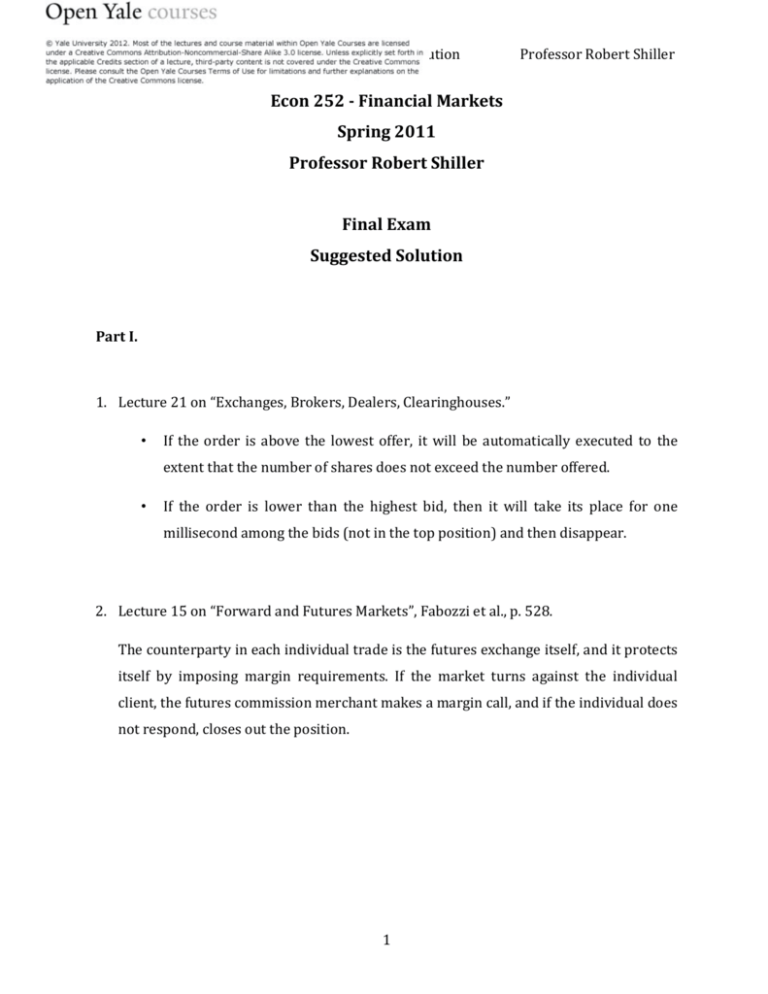
Econ 252 Spring 2011 Final Exam - Solution Econ 252 - Financial Markets Professor Robert Shiller Spring 2011 Professor Robert Shiller Final Exam Suggested Solution Part I. 1. Lecture 21 on “Exchanges, Brokers, Dealers, Clearinghouses.” • • If the order is above the lowest offer, it will be automatically executed to the extent that the number of shares does not exceed the number offered. If the order is lower than the highest bid, then it will take its place for one millisecond among the bids (not in the top position) and then disappear. 2. Lecture 15 on “Forward and Futures Markets”, Fabozzi et al., p. 528. The counterparty in each individual trade is the futures exchange itself, and it protects itself by imposing margin requirements. If the market turns against the individual client, the futures commission merchant makes a margin call, and if the individual does not respond, closes out the position. 1 Econ 252 Spring 2011 3. Guest lecture by Laura Cha. Final Exam - Solution Professor Robert Shiller She urged young people to consider financial jobs in the public sector, regulators. "People move back and forth between public and private sector." That is what she did in her career, working 14 years as a regulator before joining HSBC. The experience she got as a regulator turned out to be a career-defining advantage, made her in demand. For example, she facilitated the development of the financial sector in Hong Kong and then in China itself, in her role first at the Hong Kong Securities and Futures Commission between 1991 and 2001, as Hong Kong was transformed from a regional market to a world-wide market, and then at the China Securities Regulatory Commission between 2001 and 2004. So, after all this, she understood these markets better than anyone else, and so was in very high demand in the private sector. She also concurred that it was a rewarding experience getting the Chinese market in order, and being part of the Chinese economic revolution. 4. Lecture 20 on “Professional Money Managers and their Influence.” Any two of the following constitute a valid answer: • American Express sets up the first U.S. employee pension fund in 1875, insuring • the employee against possible hardship in retirement. • possible bankruptcy of GM. In 1950, GM creates a fully funded pension plan that is designed to survive a ERISA from 1974 requires all pensions be fully funded, sets up the Pension Benefit Guarantee Corporation to insure pension funds, requires a plan for vesting of pension benefits, and establishes the prudent person rule for • managers. • plans. Starting in 1981, defined contribution plans began to replace defined benefit In 2006, Congress encouraged pensions to put in place default participation and invest in risky assets on behalf of the pensioner. 2 Econ 252 Spring 2011 Final Exam - Solution Professor Robert Shiller 5. Lecture 12 on “Misbehavior, Crises, Regulation, and Self Regulation.” • • • • European Systemic Risk Board (ESRB) in Frankfurt, Germany, European Banking Authority (EBA) in London, UK, European Securities Markets Authority (ESMA) in Paris, France, European Insurance and Occupational Pension Authority (EIOPA) in Frankfurt, Germany. 6. Lecture 15 on “Forward and Futures Markets.” If the futures price is below the spot price at expiration date, arbitrageurs will buy contracts, take delivery and sell at the spot price. If the futures price is above the spot price at expiration date, arbitrageurs will sell contracts, buy on the spot market and deliver. Their incentive to do this ends only when spot price equals futures price. 7. Fabozzi et al., pp. 109-112. With term insurance, if the insured survives past the specified term, the policy has no value. With cash value life insurance, such as whole life, a cash value is built up, against which the owner can also borrow. 8. Fabozzi et al., p. 443. A bankers acceptance is a vehicle created to facilitate commercial trade transactions. The automobile deal between Canada and Germany is struck, with terms specifying the payment to be made and the future date of payment. The Canadian importer goes to a local bank to issue a letter of credit, which the Canadian bank sends to a German bank. As soon as the cars have shipped, the German bank pays the auto manufacturer, and presents the time draft and shipping documents to the Canadian bank, which stamps them “accepted.” The acceptance is then negotiable. 3 Econ 252 Spring 2011 9. Fabozzi et al., p. 98. Final Exam - Solution Professor Robert Shiller “Typically, umbrella insurance is pure liability coverage over and above the coverage provided by all the policies beneath it, such as homeowner, automobile, and boat policies. The name umbrella refers to the fact that it covers liability claims of all the policies underneath it. In addition to providing liability coverage over the limits of the underlying policies, it provides coverage for claims that are excluded from other liability policies such as invasion of privacy, libel, and false arrest. Typically, users of umbrella policies have a large amount of assets that would be placed at risk in the event of a catastrophic claim.” 10. Assigned reading Slapped in the Face by the Invisible Hand: Banking and the Panic of 2007 by Gary Gorton, p.10. “Intuitively, informationally-insensitive debt is debt that no one need devote a lot of resources to investigating. It is exactly designed to avoid that. Just as consumers do not spend a lot of time doing due diligence on the bank that is holding the money of someone buying something from you, the counterpart amount firms and institutional investors will turn out to be collateral, i.e., informationally-insensitive debt. Think of it as like electricity. Millions of people turn their lights on and off every day without knowing how electricity really works or where it comes from. The idea is for it to work without every consumer having to be an electrician.“ 11. Lecture 22 on “Profit and Non-Profit Finance.” The operating budget shows expenditures on current items, the capital budget also includes expenditures on capital items, such as school construction, research facilities, road maintenance and infrastructure investments. State balanced budget restrictions assert that the operating budget be balanced, but allow the government to go into debt with the capital budget, since, in the latter case, there is an offsetting investment made. 4 Econ 252 Spring 2011 12. Fabozzi et al., p. 328. Final Exam - Solution Professor Robert Shiller The Tax Reform Act of 1986 does not allow a tax deduction on debt used to finance activities that do not benefit the public at large. Also, taxable municipals may be more flexibly issued to foreigners who do not benefit from the tax advantage. 13. Lecture 19 on “Investment Banks.” The Volcker Rule, in Section 619 of the Dodd-Frank Act of 2010, has two separate parts restricting banking entities and nonbank financial companies supervised by the Federal Reserve: • • A prohibition on proprietary trading (engaging as a principal for the trading account for the their own profit). A ban on hedge fund and private equity activities. 14. Assigned Reading New Financial Order by Robert Shiller, Introduction. Rawls advocated evaluating distributive justice from what he called the “original position”: What kind of world, in the broad picture, would we like to live in, if we could choose before we were born, assuming we had an equal probability of being born anyone. Rawls theory implies that achieving justice is in fact amenable to an application of financial theory. 15. Fabozzi et al., pp. 288-289. Pricing efficiency refers to a market, where prices always fully reflect all available information. Operational efficiency refers to a market, where customers can execute transactions as cheaply as possible. 5 Econ 252 Spring 2011 16. Fabozzi et al., pp. 145-146. Final Exam - Solution Professor Robert Shiller The price at which a closed-end fund instrument trades throughout the day can be greater or less than the NAV (net asset value) of the underlying portfolios. With ETFs, authorized participants are empowered to arbitrage the difference between underlying value and the value of the fund shares. Even though the general investor is not able to do the arbitrage, the effect of the professional arbitrageurs obviates the incentive to do so. 17. Lecture 19 on “Investment Banks.” Commercial Banks receive deposits and make loans. Investment banks purchase or underwrite securities. In the US, according to the Glass Steagall Act from 1933, a financial institution could not do both, until the act was repealed in 1999. “Shadow banks” include investment banks that finance investments through repurchase agreements (repos), which are not deposits, but which are short-term like deposits. 18. Fabozzi et al., p. 389. Dark pools are electronic execution systems that do not display quotes but provide transactions at externally provided prices, often the midpoint of the best bid and offer. The pools are called “dark” in the sense that they prevent information leakage and hence are anonymous. 6 Econ 252 Spring 2011 Final Exam - Solution Professor Robert Shiller 19. Assigned reading The Gospel of Wealth and Other Timely Essays by Andrew Carnegie. As reproduced on page 9 of the 1901 edition of The Gospel of Wealth: “If this is done for affection, is it not misguided affection? Observation teaches that, generally speaking, it is not well for the children that they should be so burdened. Neither is it well for the State. Beyond providing for the wife and daughters moderate sources of income, and very moderate allowances indeed, if any, for the sons, men may well for hesitate; for it is no longer questionable that great sums bequeathed often work more for the injury than for the good of the recipients. Wise men will soon conclude that, for the best interests of their families, and of the State, such bequests are an improper use of their means . . . If any man . . . has instilled in [his sons] the sentiment that they are in a position to labor for public ends without reference to pecuniary considerations, then, of course, the duty of the parent is to see that such are provided for in moderation. There are instances of millionaire’s sons unspoiled by wealth, who, being rich, still perform great services to the community.” 20. Shiller manuscript, chapter 11. In the first G-20 summit statement in Washington DC from November 15, 2008, the leaders of the G-20 nations committed themselves to ensure that “that all systemically- important institutions are appropriately regulated. In their statement from September 15, 2009, they announced their commitment to “policies designed to avoid both the recreation of asset bubbles and the re-emergence of unsustainable global financial flows.” 7 Econ 252 Spring 2011 Part II. Final Exam - Solution Professor Robert Shiller Question 1 The relevant formula for a coupon bond is 1 1 − (1+ γ ) n M + P = C⋅ n , γ (1+ γ ) with the following notation: • • • • • P: price of the coupon bond contract today, C: coupon payment in each period, γ: yield referring to one period, M: maturity value, n: number of periods. A period refers to a six months. That is, n=210=20. (a) The question states that P=$47,000 and that M=$50,000. Because a period is half a year, the relevant yield is γ=0.53.5%=1.75%=0.0175. Analogously, the coupon payment denotes a semi-annual quantity. It follows that the coupon payment of contract A satisfies 1 1 − (1.0175) 20 50,000 + 47,000 = C⋅ 20 ⇔ C ≈ 695.93. 0.0175 (1.0175) So, the annual coupon payment is 2695.93=1,391.86, which corresponds to an annual coupon rate of 1,391.86/50,000≈2.78%. 8 Econ 252 Spring 2011 Final Exam - Solution (b) The question states that P=$175,000. Professor Robert Shiller Because a period is half a year, the relevant yield is γ=0.53%=1.5%=0.015. Analogously, the relevant coupon yield is 0.52.5%=1.25%=0.0125. It follows that the principal value of contract B satisfies 1 1 − (1.015) 20 M + 175,000 = 0.0125⋅ M⋅ 20 0.015 (1.015) 1 1 − (1.015) 20 1 + ⇔ 175,000 = M 0.0125⋅ 20 0.015 (1.015) ⇔ M ≈ 182,848.13. That is, the principal value of contract B equals approximately $182,848.13. 9 Econ 252 Spring 2011 Final Exam - Solution Question 2 (a) The loan-to-value ratio (LTV) is LTV = Professor Robert Shiller 335,000 = 0.8375 = 83.75%. 400,000 The LTV is one metric that captures the riskiness of a loan. The higher the LTV, the lower the amount by which the value of the underlying house can decrease, before the bank loses money on the mortgage in the case that a mortgage holder defaults. That is, the higher the LTV, the higher the risk of the mortgage for the bank. (b) The monthly payment is determined according to the formula i(1+ i) n MP = MB0 ⋅ , n (1+ i) −1 where • n: number of months of the mortgage loan, that is n=1215=180, • i: note rate divided by 12, that is i=7.2%/12=0.6%=0.006, • MB0: original mortgage balance, that is MB0=335,000, • MP: monthly mortgage payment. It follows that 0.006(1.006)180 MP = 335,000⋅ ≈ 3,048.66. 180 (1.006) −1 10 Econ 252 Spring 2011 Final Exam - Solution Professor Robert Shiller (c) In order to compute the amortization table for months 70 and 71, one first needs to compute the remaining mortgage balance in the beginning of month 70. This balance is computed as the outstanding mortgage balance at the end of month 69 from the following formula: (1+ i) n − (1+ i) t MBt = MB0 ⋅ , n (1+ i) −1 where • • • • n: number of months of the mortgage loan, that is n=1215=180, i: note rate divided by 12, that is i=7.2%/12=0.6%=0.006, MB0: original mortgage balance, that is MB0=335,000, MBt: remaining mortgage balance at the end of month t. It follows that (1.006)180 − (1.006) 69 MB69 = 335,000⋅ ≈ 246,543.37. (1.006)180 −1 The interest rate in a given month is computed as 0.6%, which is the note rate divided by 12, multiplied by the remaining mortgage balance in the beginning of the respective month. Subsequently, on obtains the principal repayment in a given month from the fact that the interest payment and the principal repayment in a given month add up to the monthly mortgage payment. In consequence, the full amortization table has the following form: Month 70 71 Interest Payment Principal Repayment $1,479.26 $1,569.40 $1,469.84 $1,578.82 11 Remaining Mortgage Balance in the Beginning of the Month $246,543.37 $244,973.97 Econ 252 Spring 2011 Final Exam - Solution Question 3 Professor Robert Shiller (a) The value of X’s shareholder equity is the difference between the value of X’s assets minus the value of X’s liabilities. According to X’s last quarterly filing, the value of its assets is $250,000,000 and the value of its liabilities is $200,000,000. Therefore, the value of its shareholder equity is $250,000,000 − $200,000,000 = $50,00,000. (b) Market capitalization is defined as the product of the number of shares and the share price. It follows that X’s market capitalization equals 20,000,000⋅ $6 = $120,000,000. The market capitalization substantially exceeds the value of the shareholder equity. There is therefore a lot of value in keeping the firm operating. In consequence, buying all shares of Corporation X in order to liquidate it is not reasonable. (d) Issuing the bond contract worth $1,000,000 increases X’s liabilities by exactly this amount. However, the money collected from the issuance is now cash that is available to the firm. That is, X’s assets also increase by $1,000,000. Finally, X’s equity is completely unaffected by the described bond issuance. Issuing the new shares worth $4,000,000 increases X’s equity by exactly this amount. The money collected from the issuance is now cash that is available to the firm. That is, X’s assets increase by another $4,000,000. Finally, X’s liabilities are completely unaffected by the described share issuance. In summary, the new values are as follows: • • • Assets: $255,000,000, Liabilities: $201,000,000, Equity: $54,000,000. 12 Econ 252 Spring 2011 Final Exam - Solution Question 4 Professor Robert Shiller (a) The dividend payment of $6 for asset X translates into a dividend rate of 4%, as 6/200=0.03. The fair value of the described futures contract is given by the expression (1+r-y)spot price of asset X, where r is the riskless interest rate and y is the dividend rate for asset X. In consequence, the fair value of the described futures contract is (1+0.04-0.03)200=202. Therefore, when the actual futures price is $210, one would necessarily have to implement the “cash and carry trading strategy.” However, this strategy entails purchasing asset Y, which the investor is contractually barred to do. Therefore, it is not possible to exploit this arbitrage opportunity. (b) As computed in part (a), the fair value of the described futures contract is $202. Therefore, when the actual futures price is $190, an investor can make a riskless profit without using any of his own capital with a “reverse cash and carry trading strategy”: • Period 0: 1. Buy futures contract. 2. Short-sell the underlying asset, and receive $200. • 3. Lend $200. Period 1: 1. Receive $208=1.04$200 from loan. 2. Receive the asset from futures contract, and pay $190. 3. Return the asset from futures contract, and pay $6 dividend to settle shortsale. The total arbitrage profit from these transactions is $12. 13 Econ 252 Spring 2011 Question 5 Final Exam - Solution (a) 14 Professor Robert Shiller Econ 252 Spring 2011 Final Exam - Solution Professor Robert Shiller (b) The expected returns of all three portfolios do not depend on the correlation between assets A and B. Therefore, the expected returns are: • • • w=1.3: 4.25% expected return, w=0.7: 2.75% expected return, w=0 (asset B): 1.0% expected return. With respect to the return standard deviations, consider: For w=1.3: Var(rP ) = Var(1.3⋅ rA − 0.3⋅ rB ) = (1.3) 2 ⋅ Var(rA ) + (−0.3) 2 ⋅ Var(rB ) + 2⋅ 1.3⋅ (−0.3)⋅ Corr(rA ,rB )⋅ Std(rA )⋅ Std(rB ) = (1.3) 2 ⋅ (0.45) 2 + (−0.3) 2 ⋅ (0.35) 2 + 2⋅ 1.3⋅ (−0.3)⋅ (−0.4)⋅ 0.45⋅ 0.35 ≈ 0.4024 = 40.24%. Std(rP ) = Var(rp ) = 0.4024 ≈ 0.6343 = 63.43%. For w=0.7: Var(rP ) = Var(0.7⋅ rA + 0.3⋅ rB ) = (0.7) 2 ⋅ Var(rA ) + (0.3) 2 ⋅ Var(rB ) + 2⋅ 0.7⋅ 0.3⋅ Corr(rA ,rB )⋅ Std(rA )⋅ Std(rB ) = (0.7) 2 ⋅ (0.45) 2 + (0.3) 2 ⋅ (0.35) 2 + 2⋅ 0.7⋅ 0.3⋅ (−0.4)⋅ 0.45⋅ 0.35 ≈ 0.0838 = 8.38%. Std(rP ) = Var(rp ) = 0.086 ≈ 0.2895 = 28.95%. w=0 corresponds to asset B. Its standard deviation is unaffected by changes the correlation between assets A and B. Therefore, the return standard deviation for w=0 is 35%. 15 Econ 252 Spring 2011 Final Exam - Solution Professor Robert Shiller (c) It is true that the decrease in correlation strictly decreases the return standard deviation for w=0.7 (and more generally for any 0<w<1) and it remains constant for w=0 (and more generally for w=0 and w=1). However, the return standard deviation strictly increases for w=1.3 (and more generally for w<0 and w>1). That is, in the latter cases, the described investor is not at least well off as before. In consequence, lowering the correlation between assets A and B does not always entail diversification benefits. (d) 16 Econ 252 Spring 2011 Question 6 Final Exam - Solution Professor Robert Shiller The payoff of the described portfolio at maturity is obtained as follows: Underlying ST≤50 50<ST≤70 70<ST≤100 ST>100 Payoff Put P1 with E=100 Payoff Put P2 with E=70 Payoff Put P3 with E=50 Payoff Portfolio P1-P2-P3 100-ST 100-ST 100-ST 0 50-ST 0 0 0 70-ST 70-ST ST-20 30 0 100-ST 0 0 The portfolio P1-P2-P3 costs $55-$29-$16=$10. It follows that the profit of the portfolio at maturity is as follows: Underlying ST≤50 50<ST≤70 70<ST≤100 ST>100 Profit Portfolio P1-P2-P3 ST-30 20 90-ST -10 17 Econ 252 Spring 2011 Final Exam - Solution Professor Robert Shiller An investor might want to construct this portfolio if he thinks that the underlying security will experience little volatility between the time of construction and the maturity date. Moreover, he is more worried about price increases, which is why there is a floor in the losses from high prices, than he is worried about price decreases. 18 Econ 252 Spring 2011 Question 7 Final Exam - Solution Professor Robert Shiller The price of the underlying XYZ evolves as follows: • A year from now: S(u) = u⋅ S(0) = 150,S(d) = d⋅ S(0) = 50. • Two years from now: S(uu) = u 2 ⋅ S(0) = 225,S(ud) = S(du) = u⋅ d⋅ S(0) = 75,S(dd) = d 2 ⋅ S(0) = 25. (a) The one-period Binomial Asset Pricing Model has the following schematic form: The relevant quantity is the one-period hedge ratio for the call option C1. H= C1 (u) − C1 (d) max[150 − 60,0] − max[50 − 60,0] ⇔H= = 0.9. (u − d)⋅ S(0) (1.5 − 0.5)⋅ 100 (b) The desired quantity is C1(0), which satisfies the following identity: H⋅ S(u) − C1 (u) 0.9⋅ 150 − max[150 − 60,0] = 1+ r ⇔ = 1.02 H⋅ S(0) − C1 (0) 0.9⋅ 100 − C1 (0) ⇔ C1 (0) ≈ 45.88. 19 Econ 252 Spring 2011 Final Exam - Solution Professor Robert Shiller (c) The two-period Binomial Asset Pricing Model has the following schematic form: The desired quantity C2(0) will be obtained via backward induction. At the upper node in period 1, that is, after the stock price increases once: H(u) = C2 (uu) − C2 (ud) max[225 − 60,0] − max[75 − 60,0] ⇔ H(u) = = 1. (u − d)⋅ S(u) (1.5 − 0.5)⋅ 150 Furthermore, the price of C2 at the upper node in period 1 satisfies the following identity: H⋅ S(uu) − C2 (uu) 1⋅ 225 − max[225 − 60,0] = 1+ r ⇔ = 1.02 H⋅ S(u) − C2 (u) 1⋅ 150 − C2 (u) ⇔ C2 (u) ≈ 91.18. 20 Econ 252 Spring 2011 Final Exam - Solution Professor Robert Shiller At the bottom node in period 1, that is, after the stock price increases once: H(d) = C2 (du) − C2 (dd) max[75 − 60,0] − max[25 − 60,0] ⇔ H(d) = = 0.3. (u − d)⋅ S(d) (1.5 − 0.5)⋅ 50 Furthermore, the price of C2 at the bottom node in period 1 satisfies the following identity: H⋅ S(du) − C2 (du) 0.3⋅ 75 − max[75 − 60,0] = 1+ r ⇔ = 1.02 H⋅ S(d) − C2 (d) 0.3⋅ 50 − C2 (d) ⇔ C2 (d) ≈ 7.65. Hence, C2(d)≈$7.65 is the answer to the first question. Finally, at the initial node: H(0) = C2 (u) − C2 (d) 91.18 − 7.65 ⇔ H(0) = = 0.8353. (u − d)⋅ S(0) (1.5 − 0.5)⋅ 100 Furthermore, the price of C2 at the initial node satisfies the following identity: H⋅ S(u) − C2 (u) 0.8353⋅ 150 − 91.18 = 1+ r ⇔ = 1.02 H⋅ S(0) − C2 (0) 0.8353⋅ 100 − C2 (0) ⇔ C2 (0) ≈ 50.08. Hence, C2(0)≈$50.08 is the answer to the second question. 21 Econ 252 Spring 2011 (d) Recall that put-call parity is Final Exam - Solution C+ Professor Robert Shiller E = S + P, (1+ r)T where T denotes time to maturity. It holds at any time period and for any state of the stock price evolution. Therefore, the price of a 2-year put with the same strike price as C2 a year from now after the price has gone down once is 7.65 + 60 = 50 + P(d) ⇔ P(d) = 16.47. 1+ 0.02 Analogously, the price of this put option today is: 50.08 + 60 = 100 + P(0) ⇔ P(0) = 7.75. (1+ 0.02) 2 22
